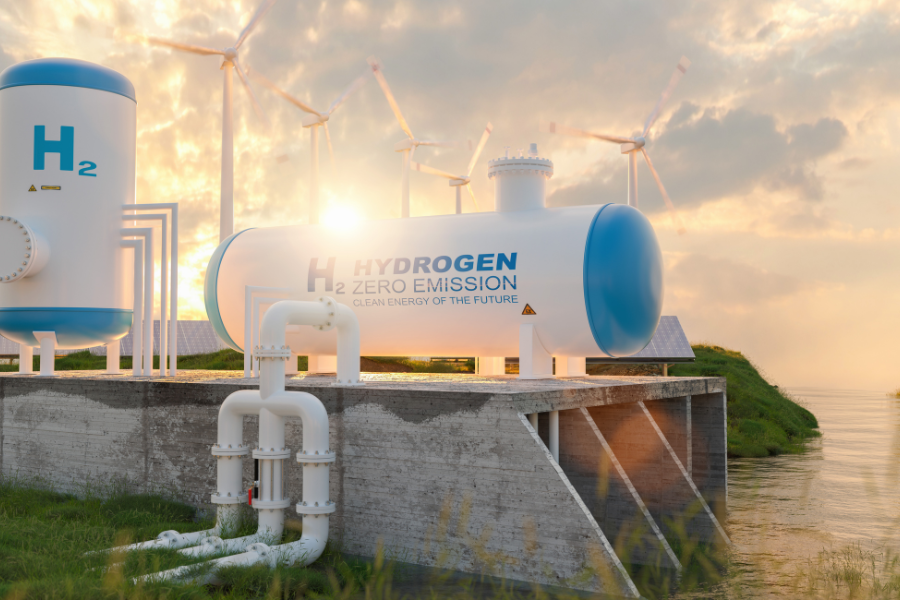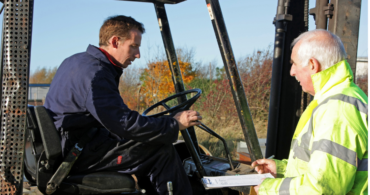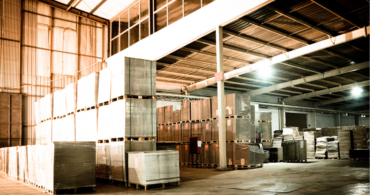There are more than 850,000 forklifts in the U.S., and more than 60% are electric. As electric forklifts continue to increase in popularity, new technologies will further boost their performance and efficiency. One of those exciting new technologies is already here: hydrogen batteries.
In the 2022 film “The Glass Onion,” the most recent outing for Foghorn Leghorn-accented detective Benoit Blanc (spoilers ahead; so, skip to the next paragraph if you’ve yet to journey to “The Glass Onion”), a genius inventor believes he created the perfect power source using hydrogen. The subsequent explosion and destruction of his vacation home, the aforementioned Glass Onion, (and the “Mona Lisa” to boot) prove that he is less genius and more doofus.
However, in this instance, the screenwriter’s imagination lags far behind real life. Hydrogen batteries already power vehicles in public and private sectors (for example, more than 50,000 hydrogen fuel cell electric forklifts operate nationwide). Also, for anyone concerned about a Glass Onion-level (or Hindenburg-esque) explosion, hydrogen fuel is as safe as other transportation fuels, such as gasoline, diesel and natural gas. Hydrogen fuel is stored in carbon-fiber reinforced tanks that undergo rigorous testing to ensure they can withstand double the pressure of what’s applied during everyday use.
Hydrogen is a zero-emission fuel source because its only byproduct is water vapor. That’s why a hydrogen fuel cell forklift is also called a green forklift. However, for genuinely green forklifts, it is necessary to know how the hydrogen fuel is produced.
What is hydrogen?
Hydrogen is the first element on the periodic table, identified by the elemental symbol “H.” It is an odorless, tasteless, non-toxic gas that is also highly combustible.
Hydrogen is the most abundant element in the universe. However, this does not mean that it is simple to acquire. In nature, hydrogen is never found in its pure state. It is always combined with other elements, such as oxygen to form water (H20) or carbon to create methane (CH4). To procure pure hydrogen, it must be separated from other compounds.
The process of hydrogen separation is nothing new. In fact, hydrogen is used for many industrial purposes today, including ammonia production and petroleum refining. The most common method of hydrogen separation is known as steam methane reforming. During this process, high-temperature steam is used to break up natural gas into its base elements, which include hydrogen.
The issue many people have with steam methane reforming is that it is very energy intensive. The process also releases pollutants into the atmosphere, including carbon dioxide and occasionally methane. It’s hard to accept hydrogen fuel as a zero-emission energy source when refining it creates those emissions anyway.
Fortunately, there are alternative refinement processes that are more environmentally friendly. One is electrolysis, which forces an electrical current through water to break it into hydrogen and oxygen. The caveat to electrolysis is that the electricity needs to come from an environmentally friendly source (such as solar, wind, hydro, etc.) for the hydrogen to be considered green. Scientists are also investigating other environmentally friendly hydrogen separation processes, including ways to derive hydrogen from plants and landfill waste cleanly.
Once the hydrogen is extracted, it is stored in tanks where it waits to power fuel cells.
How do hydrogen fuel cells work?
A fuel cell generates electricity through an electrochemical reaction instead of burning a fuel source like a combustion engine. Here’s how hydrogen fuel cells work.
A fuel cell consists of three components: an anode, a cathode and an electrolyte membrane. The anode and cathode are on opposite sides of the fuel cell, separated by the electrolyte membrane. A circuit also runs from the anode to the cathode, bypassing the electrolyte membrane.
Hydrogen enters the fuel cell at the anode. At the same time, oxygen is pumped into the cathode. When the hydrogen hits the anode, a catalyst splits the hydrogen molecules into electrons and protons.
After the hydrogen molecules are split, the negatively charged electrons leave the anode along the circuit, generating heat and an electric current that powers a hydrogen forklift. The electrons’ journey concludes at the cathode.
The hydrogen protons take a much different route. Instead of traveling through a circuit, the positively charged protons pass through the electrolyte membrane to reach the cathode. In the cathode, the protons reunite with the electrons and mingle with the oxygen to form the only byproduct generated by a fuel cell: water.
There’s a lot of activity going on in a single fuel cell, and it produces less than one volt of electricity, which is insufficient to power a toy forklift, much less a 2,000-pound industrial machine. That’s why hydrogen batteries are comprised of numerous fuel cells known as a fuel cell stack. Typically, fuel cell stacks consist of hundreds of fuel cells.
What are the advantages of fuel cell technology?
A fuel cell forklift is like a battery-powered forklift. However, unlike a battery, a fuel cell never runs down or needs recharging. Instead, it takes about five minutes to refill the tank when the hydrogen runs low.
The issue is getting the hydrogen to refill the tank. Creating an infrastructure of hydrogen refueling stations is the primary concern holding back the availability of hydrogen fuel cell vehicles to the public. There are approximately 15,000 hydrogen-powered vehicles on public roads, and all of them are in California, which is the only state with retail hydrogen fueling stations.
Currently, it makes more sense for industries to use hydrogen fuel cell vehicles. Unlike passenger vehicles that travel irregular routes and far distances, the usage of an industrial vehicle is much more predictable. For example, hydrogen batteries are used in warehouse forklifts that never journey far from their home base and passenger busses that follow the same route daily.
Those vehicles enjoy the advantages of hydrogen fuel cells, which include the following:
- Quiet; fuel cells help to reduce noise pollution because they have no moving parts.
- Quick and easy refueling; the time spent filling a hydrogen fuel tank is about as long as it takes to fuel a passenger vehicle.
- Less maintenance than lead-acid batteries, forklift fuel cell batteries never need to be watered, equalized or charged.
- Environmentally friendly; a hydrogen forklift is a zero-emission vehicle, and hydrogen fuel can be produced in ways that don’t rely on natural resources or emit pollutants.
- Reliable; hydrogen fuel cells are not affected by extreme temperatures or rugged environments.
- Energy efficient; a fuel cell system uses 60% of the fuel’s energy (the average combustion engine in a passenger vehicle is less than 20% efficient in converting gasoline to power).
Are hydrogen batteries right for you?
Green forklifts can reduce harmful pollutants and improve operational efficiencies by reallocating time previously spent on forklift maintenance. So, the answer to “Are hydrogen batteries right for you?” is clearly…
Maybe. As noted, there are many advantages of hydrogen fuel cells. However, it’s impossible to identify your unique needs through a blog.
That’s why Texas Motive Solutions offers a complimentary forklift fleet performance analysis. We believe there is no “best” forklift battery except the one that’s best for you. Once we understand your business needs, we can discover whether hydrogen batteries (which we have in stock) or another option is your ideal battery solution.
To schedule a complimentary analysis and for all forklift battery and forklift battery repair needs, please give us a call at (888) 316-2459. You can also fill out a form to learn about our services and discover everything we can do for you.


